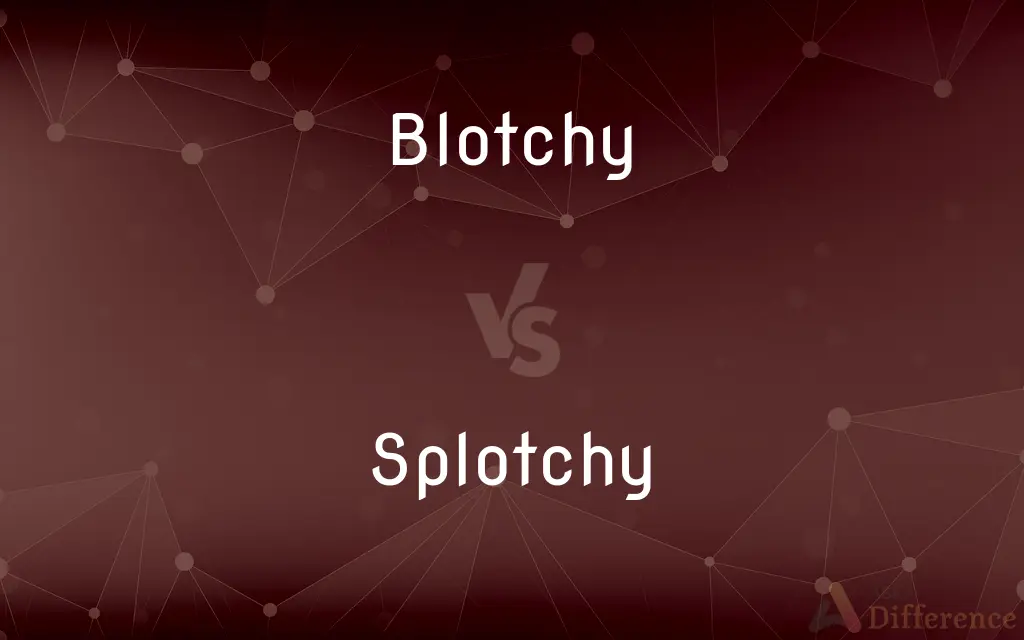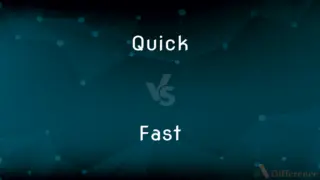Blotchy vs. Splotchy — What's the Difference?
By Urooj Arif & Fiza Rafique — Updated on April 26, 2024
Blotchy refers to an uneven pattern of marks or spots, often suggesting discoloration, while splotchy indicates random, irregularly shaped spots or stains, typically larger.

Difference Between Blotchy and Splotchy
Table of Contents
ADVERTISEMENT
Key Differences
Blotchy skin or material often displays an irregular pattern of coloration, giving a mottled appearance that suggests inconsistency in texture or color. On the other hand, splotchy is used to describe larger, more pronounced spots that stand out due to their shape and size.
In describing artwork or a finish on a surface, blotchy might be used to critique an uneven application of paint or varnish, whereas splotchy might refer to unintentional large marks made by the paint.
Blotchy can also be used in a metaphorical sense to describe an inconsistent or flawed appearance in abstract concepts like a performance or piece of work, while splotchy tends to remain more concrete, focusing on visual and physical characteristics.
In textiles, a blotchy fabric may result from uneven dyeing or fading, presenting a lackluster appearance, whereas splotchy fabric typically results from stains or spills that cause distinct large spots.
When observing patterns in nature, such as on animals or leaves, blotchy describes subtle variegations that blend into one another, whereas splotchy often refers to distinct and separate marks that are easily identifiable.
ADVERTISEMENT
Comparison Chart
Definition
Showing an uneven distribution of color or marks.
Covered in large, irregular spots or stains.
Typical Usage
Used to describe skin, fabric, or finishes.
Often used to describe stains or marks.
Connotation
Implies a subtle, often negative, variation.
Implies bold, noticeable inconsistencies.
Example in Nature
Blotchy patterns on a camouflaged animal.
Splotchy markings on a brightly colored frog.
Example in Art
A blotchy watercolor painting due to uneven application.
A splotchy canvas caused by drops of thick paint.
Compare with Definitions
Blotchy
Exhibiting unevenness in texture or color.
The blotchy varnish made the handmade table look old.
Splotchy
Characterized by random or chaotic spotting.
The splotchy pattern on the fabric made it unsuitable for formal wear.
Blotchy
Marked by patches of different color or shades that do not form a consistent pattern.
The blotchy appearance of his sunburn worried him.
Splotchy
Covered with noticeable and distinct patches.
Her splotchy painting was surprisingly captivating.
Blotchy
Having spots or marks that blend into each other.
The blotchy leaves were a sign of the plant disease.
Splotchy
Resulting from spillage or accidental marking.
The floor was splotchy after the paint can tipped over.
Blotchy
Describing an inconsistent or flawed execution.
His performance was blotchy, lacking consistent quality.
Splotchy
Having irregular spots or marks, often large.
The old manuscript was covered in splotchy ink stains.
Blotchy
Resulting from poor or uneven application.
The paint job was blotchy due to the hurried work.
Splotchy
Visually striking due to prominent spots.
The splotchy fur of the dog made him a favorite at the show.
Blotchy
A spot or blot; a splotch.
Splotchy
An irregularly shaped spot, stain, or colored area.
Blotchy
A discoloration on the skin; a blemish.
Splotchy
To mark with splotches or a splotch.
Blotchy
To mark or become marked with blotches.
Splotchy
Marked or covered with large, irregular spots
Blotchy
Covered in blotches.
Splotchy
Covered or marked with splotches.
Blotchy
Having blotches.
Blotchy
Marked with irregularly shaped spots or blots
Blotchy
Marred by discolored spots or blotches;
Blotchy skin
Common Curiosities
Is blotchy always negative?
Often, but not always, as it can add character or uniqueness to items like antique furniture or artwork.
What causes blotchy skin?
Blotchy skin can be caused by factors like uneven pigmentation, sun exposure, or skin conditions.
How do blotchy and splotchy differ in textile applications?
Blotchy often results from dyeing errors, while splotchy usually results from stains or intentional large designs.
Can blotchy and splotchy be used interchangeably?
While both describe irregular patterns, they are not interchangeable due to differences in the prominence and size of the marks.
What is the main difference between blotchy and splotchy?
Blotchy refers to uneven, often subtle marks or discolorations, whereas splotchy describes large, distinct spots or stains.
Is blotchy suitable for describing animal markings?
Yes, especially when the markings blend smoothly without sharp separations.
Why might a painter want to avoid a splotchy effect?
A splotchy effect can be undesirable if uniformity or subtlety is the goal, as it tends to stand out and can seem chaotic.
Which is more noticeable, blotchy or splotchy?
Splotchy is generally more noticeable due to its larger and more distinct markings.
Can blotchy be a style choice in art?
Yes, artists might choose a blotchy style to convey a sense of movement or emotion.
Can fabrics be both blotchy and splotchy?
Yes, fabrics can exhibit both characteristics, especially if stained or poorly dyed.
What is a common remedy for blotchy skin?
Treatments vary but can include moisturizing, exfoliating, and using products that even out skin tone.
What are common contexts for using splotchy?
Splotchy is common in describing artistic works, stains, or distinctive patterns on animals.
Share Your Discovery

Previous Comparison
Jute vs. Hessian
Next Comparison
Quick vs. FastAuthor Spotlight
Written by
Urooj ArifUrooj is a skilled content writer at Ask Difference, known for her exceptional ability to simplify complex topics into engaging and informative content. With a passion for research and a flair for clear, concise writing, she consistently delivers articles that resonate with our diverse audience.
Co-written by
Fiza RafiqueFiza Rafique is a skilled content writer at AskDifference.com, where she meticulously refines and enhances written pieces. Drawing from her vast editorial expertise, Fiza ensures clarity, accuracy, and precision in every article. Passionate about language, she continually seeks to elevate the quality of content for readers worldwide.














































